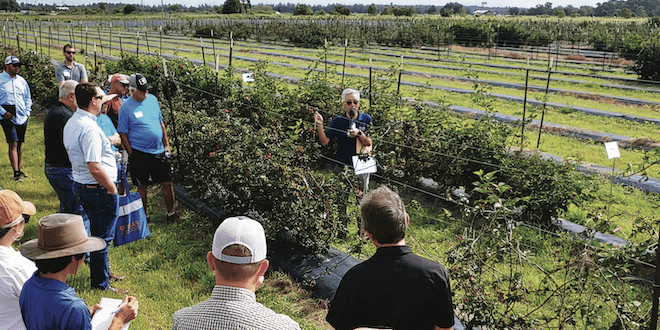
Jun 10, 2022First UF blackberry day shows challenges, opportunities
At Florida’s inaugural blackberry field day, growers discussed challenges of the crop, which is experiencing increasing consumer demand.
During the May 25 event at the University of Florida Institute of Food and Agricultural Sciences’ (UF/IFAS) Gulf Coast Research and Education Center in Wimauma, plant scientists, agronomic specialists and Extension agents provided attendees information about blackberries in the Sunshine State.
Zhanao Deng, professor of environmental horticulture, reviewed varieties and discussed conditions that can affect blackberry production in Florida. Wind chill hours are critical in plant development. He compared average chill hours in Balm (central Florida) to those in Citra, 100 miles to the north. Balm averages 220 chill hours to Citra’s 419. In 2021, Balm received 162 chill hours while Citra saw 370.
Warm fall weather, similar day/ night-time temperatures during berry ripening, sandy soil and frequent thunderstorms, can affect plant growth, harvesting, cane tipping and disease management.
“We know from blueberries and peaches when we have enough chill hours,” Deng said. “Fruit will be much smaller if we don’t get enough.”
Osage, a variety with strong potential for Florida, tends to produce small fruit. A lack of acidity, however, makes it popular with consumers, Deng said. The Ponca variety has firm fruit, with 80% of its berries marketable. Prime-Ark 45 incorporates high flavor with other traits. Prime-Ark Freedom is the highest-yielding in UF trials, producing up to 7.7 pounds of berries per plant.
Prime-Ark Freedom is the most adapted variety that John Clark, renowned University of Arkansas fruit breeder, has observed in Florida. The berries didn’t show storage potential, so the variety was targeted to home gardeners and farm markets when it was released in 2013. But with low chill hour requirements of 100 hours, the Prime-Ark Freedom is showing promise in Florida.
During field tours, Clark said Osage showed good production while Natchez grew poorly. Ponca isn’t as early as Prime-Ark Freedom, but is larger than Osage and has yields equal to Ouachita. Caddo, a new variety, stores well, produces large fruit and is a consistent yielder.
“In the last 10 years, it has been interesting with all the people asking me about growing blackberries in Florida,” Clark said.
Mexico supplies up to 75% of commercial blackberries in the U.S., he said, and growers must be mindful of overlap with its late September to June season. Florida produces blackberries from April through early June.
“If you try to grow and compete with that, it will be tough,” he said. “The key thing in the blackberry business is to make sure you know a way to get the price you need.”
In addition to developing new cultivars, UF/IFAS scientists are examining how fertilizers, diseases, pests and weeds affect blackberry yield and quality.
Microscopic nematodes feed on blackberry roots and leaves, and growers often confuse the symptoms because the pest is so small, said nematologist Johan Desaeger.
“They’re tiny but cause a lot of problems,” he said. “They are probably one of the most underestimated agricultural pests in the world. The main nematode we’re concerned about doesn’t seem to be an issue in blackberries, which is good news.”
Spiral nematodes and others, including dagger, lesion and stubby root, can grow to large populations, causing economic damage to a berry crop, said Desaeger.
Growers should look out for orange felt or orange blotch, orange rust, cane blight and rosette or double blossom. Spread via water, phytophthora root rot produces zoospores and is often problematic in poorly drained areas, damaging roots and leading to primocane collapse.
“Starting with clean plant stock is highly recommended,” said Natalia Peres, professor of plant pathology. “Many viral diseases affect caneberries, including blackberry yellow vein disease.”
Barrier mulches are important for weed management. Nathan Boyd, professor of horticulture, advised minimizing transplant holes as much as possible. Most growers control planting hole weeds via hand weeding.
“Anywhere there is a hole in your plastic, you will have a problem,” Boyd said. “You want to do all you can to seal those holes. I know you have to let that plant grow, but the bigger the hole you have, the more weeds you will have and the more effort you will have to put into it.”
A growers panel also featured insight. John Hoblick, who handles farm sales for AgriStarts, a Florida tissue culture propagation company that supplies blackberry plants, said many smaller operators experienced strong sales during the Covid-19 pandemic because consumers who wanted to get out of their homes flocked to farm stands.
“If it were me, I would be happy putting in a u-pick of some sort,” Hoblick said. “As far as quality berries are concerned, from a consumer perspective, it is good to have better selections, like these new ones from Arkansas that are notably better than the average and have higher brix.
“Getting them in the clamshells in the grocery stores will help, as there is increasing public demand for them,” he said. “Because there are so many blackberries out there, it will have to turn into quality vs. quantity. The varieties are getting better and better. It will be better for everyone.”
– Doug Ohlemeier, assistant editor














